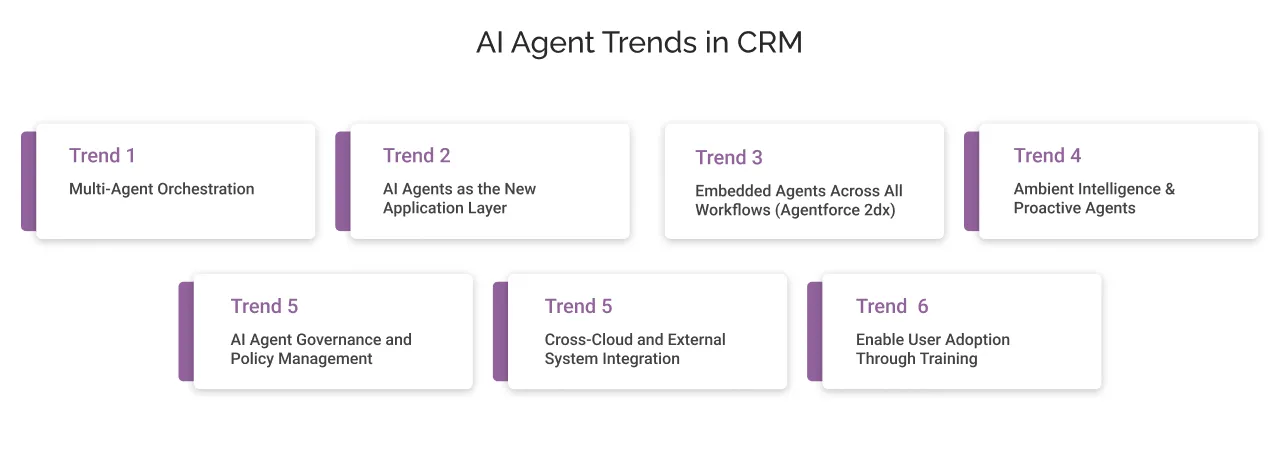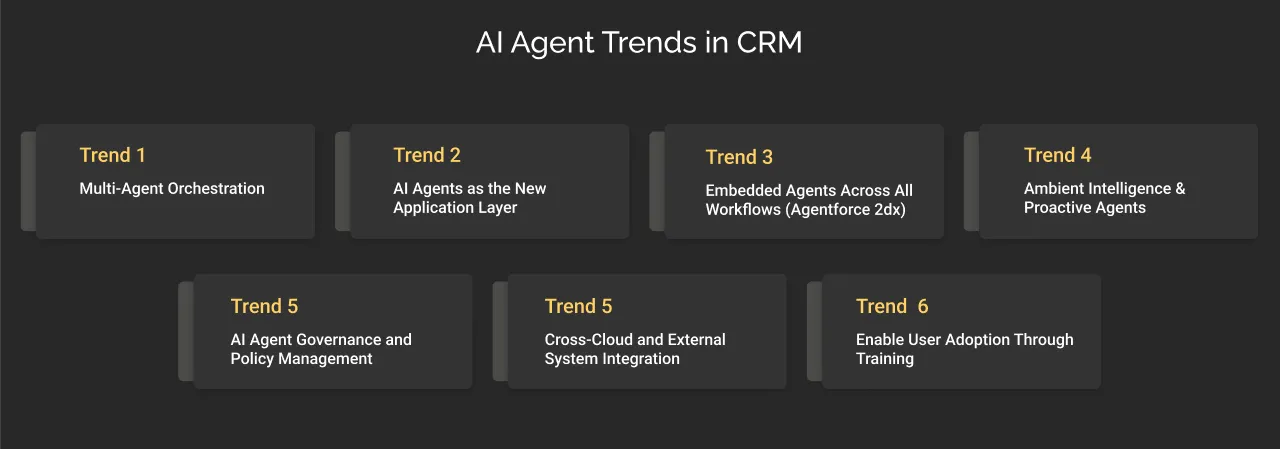Agentforce 2024–2025: Statistics, Success Stories, and Salesforce’s AI Agent Trends
Table of Contents
Agentforce has gone past early adoption. It’s now driving real results in various industries. In less than six months, it closed over 5,000 deals. This effort generated over $900M in AI and Data Cloud revenue. Major brands like Indeed, OpenTable, and Formula 1 are using it.
Agentforce is part of sales, service, and commerce teams. It helps businesses grow faster, provide round-the-clock support, all without hiring more staff.
This blog explains the numbers, industries, and trends that fueled Agentforce’s rise. It shows why more companies trust it as their AI foundation.
Salesforce Agentforce Revenue Q4 FY25
In the final quarter of fiscal year 2025, Salesforce saw strong growth in Data Cloud and AI. This happened due to the rising adoption of Agentforce.
Below is the confirmed performance summary based on Salesforce revenue report:
Q4 FY25 Results
| Total Revenue | $10.0 billion |
| AI + Data Cloud Annual Recurring Revenue | $900 million (up by 120% Y/Y) |
| Closed Deals | 5000 (out of which 3000 is paid) |
| Salesforce Data Cloud Scale | 50 trillions records, doubling Y/Y |
Within Salesforce’s own operations, Agentforce handled over 380,000 customer support interactions. It also resolved 84% cases on its own, requiring human help for 2% of them. This shows the increasing need for and trust in this AI solution.
Agentforce by the Numbers (2024–2025)
Agentforce’s first full year has been anything but quiet. Companies are getting benefitted as it boosts productivity and reduces manual labor. This all takes place without compromising trust or governance of data and systems.
Here are some numbers showing how its adoption started & expanded:


1. 10,000+ Agents Created in 3 days
At Dreamforce 2024, attendees created more than 10,000 AI agents within three days, highlighting the strong interest across technical and non-technical users alike. Since then, Agentforce has been adopted by leading giants, including Indeed, Finnair, Heathrow Airport, Saks and SharkNinja to scale operations with digital labor.
2. Resolving 83% of Queries without human support
Salesforce’s internal help portal has now resolved 83% of customer service queries autonomously all with the help of Agentforce, cutting down the need for agent escalation nearly in half.
3. AI means lower churn and higher growth
Teams that have implemented AI, including Agentforce, are experiencing measurable business benefits. As per the Salesforce State of Sales report, AI-enabled teams experience lower turnover, improved quote attainment, and higher growth.
4. 4 Trillion+ Flows Already Built
Agentforce connects directly with Salesforce Flows. Customers have created over 4 trillion automations, saving 5.6 billion hours of work. AI agents can now use these automations as actions. This improves their ability to get real work done.
Agentforce Customers Across Industries And Regions
Agentforce is taking away the stress of maintaining operational efficiency across different industries. This enables businesses to leverage the high-end capabilities of new-age AI. And Salesforce has got successful stories of some of them as well.
To understand the full impact, let’s look at how widely Agentforce has been adopted across the market.
How Many Customers Does Agentforce Have (Till May 2025)?
Salesforce’s Q4 FY25 report shows that Agentforce has closed 5,000 deals. Out of these, 3,000 are paid.
Nearly 50% of Fortune 100 companies are using Salesforce Data Cloud and AI. This indicates their growing popularity and trust of customers. The claimed revenue is $900 million by May 2025. Notably, all of Salesforce’s top 10 Q4 customer wins include data and AI as core components.
Top Companies using Agentforce
Many of the world’s leading companies that use Agentforce are based in the United States. Below is a curated list of organizations leveraging AI Agents from Salesforce across the U.S.:
- AAA
- Goodyear
- Camping World
- Equinix
- Saks Fifth Avenue
- CentralSquare
- ezCater
- OpenTable
Industries using Salesforce Agentforce
Across industries, the demand for intelligent and scalable automation is growing. Salesforce Agentforce is making sure to deliver this demand at best.
It’s not just a regular chatbot; it’s the ultimate Digital Labor platform. It enables AI agents to do tasks that are keeping your team occupied unnecessarily.
- Retail & Consumer Goods
| Company Name | Headquarters | Industry | Agentforce Use Case |
|---|---|---|---|
| Saks | New York, New York, USA | Retail | Elevated luxury shopping experience by unifying data and AI Service Agents. |
| SharkNinja | Needham, Massachusetts, USA | Consumer Goods | Enhanced product development and customer engagement through AI-driven insights. |
- Financial Services
| Company Name | Headquarters | Industry | Agentforce Use Case |
|---|---|---|---|
| Sammons Financial Group | West Des Moines, Iowa, USA | Financial Services | Enhanced customer service and policy management using Agentforce. |
| Indeed | Austin, Texas, USA | Employment Services | Improved job matching algorithms and employer services through Agentforce. |
- Insurance
| Company Name | Headquarters | Industry | Agentforce Use Case |
|---|---|---|---|
| Young Drivers | Canada | Automotive Insurance | Scaling customer support and scheduling with Agentforce to meet growing customer demands. |
- Professional Services
| Company Name | Headquarters | Industry | Agentforce Use Case |
|---|---|---|---|
| Mike Morse Law Firm | Southfield, Michigan, USA | Legal Services | Boosted productivity by 35% with Salesforce AI insights. |
| 1-800Accountant | New York, New York, USA | Accounting Services | Automated client onboarding and support using Agentforce. |
| Capita | London, UK | Business Services | Enhanced service delivery and client engagement through Agentforce. |
| Vivint | Provo, Utah, USA | Home Security | Streamlined customer support and installation scheduling using Agentforce. |
| AAA Washington | Bellevue, Washington, USA | Travel & Insurance Services | Enhanced member services and roadside assistance coordination through Agentforce. |
- Healthcare & Life Sciences
| Company Name | Headquarters | Industry | Agentforce Use Case |
|---|---|---|---|
| Adobe Population Health | San Francisco, California, USA | Healthcare | Improved patient data management and care coordination with Agentforce. |
| Precina | San Diego, California, USA | Healthcare | Leveraged Agentforce for advanced analytics in patient care. |
| Amplifon | Milan, Italy | Healthcare (Hearing Aids) | Tailored hearing care with smart scheduling through autonomous agents. |
| Wellness Extract | Vancouver, Canada | Health Supplements | Streamlined customer inquiries and order processing using Agentforce. |
| Transcend | USA | Telehealth | Offering 24/7 personalized telehealth support with a limitless workforce to meet increasing demand. |
- Travel & Hospitality
| Company Name | Headquarters | Industry | Agentforce Use Case |
|---|---|---|---|
| OpenTable | San Francisco, California, USA | Hospitality | Enhanced customer service experiences using Agentforce. |
| ezCater | Boston, Massachusetts, USA | Food Services | Transformed customer experience through Agentforce integration. |
| Secret Escapes | London, UK | Travel & Hospitality | Delivered fast, 24/7 support with autonomous agents for travelers. |
| Engine | USA | Travel Platform | Autonomously resolving over half a million inquiries annually, allowing reps to focus on providing personalized service. |
- Education
| Company Name | Headquarters | Industry | Agentforce Use Case |
|---|---|---|---|
| Wiley | Hoboken, New Jersey, USA | Publishing | Achieved a 213% ROI by streamlining operations with Agentforce. |
| Carnegie Learning | Pittsburgh, Pennsylvania, USA | Education Technology | Enabled sales teams to focus more on selling by automating processes with Agentforce. |
| Unity Environmental University | New Gloucester, Maine, USA | Higher Education | Improved student engagement and administrative efficiency through Agentforce. |
- Manufacturing
| Company Name | Headquarters | Industry | Agentforce Use Case |
|---|---|---|---|
| Kawasaki Engines | Maryville, Missouri, USA | Manufacturing | Boosted customer satisfaction by integrating Agentforce for efficient service management. |
| Fisher & Paykel | East Tamaki, Auckland, New Zealand | Manufacturing | Streamlined operations and improved customer service using Agentforce. |
| Luminator | Plano, Texas, USA | Manufacturing | Leveraged Agentforce to optimize production processes and supply chain management. |
- Nonprofit
| Company Name | Headquarters | Industry | Agentforce Use Case |
|---|---|---|---|
| Big Brothers Big Sisters of America | USA | Nonprofit Mentorship | Assisting matching specialists to find the right mentor-mentee pairs in half the time, enhancing one-to-one mentorship programs. |
| College Possible | Saint Paul, Minnesota, USA | Nonprofit Education | Enhanced student support services and donor engagement using Agentforce. |
- Infrastructure & Public Services
| Company Name | Headquarters | Industry | Agentforce Use Case |
|---|---|---|---|
| The Adecco Group | Zurich, Switzerland | Staffing Services | Improved talent matching and client services with Agentforce. |
| CentralSquare Technologies | Lake Mary, Florida, USA | Public Sector Software | Streamlined municipal operations and citizen engagement using Agentforce. |
| Sweeping Corp | Cleveland, Ohio, USA | Environmental Services | Optimized scheduling and service delivery through Agentforce. |
- Sports & Entertainment
| Company Name | Headquarters | Industry | Agentforce Use Case |
|---|---|---|---|
| Formula 1 | London, UK | Sports & Entertainment | Speeded up service response by 80% with personalized fan experiences. |
| Equinox | New York, New York, USA | Fitness & Wellness | Improved member engagement and class scheduling using Agentforce. |
- Aviation & Transportation
| Company Name | Headquarters | Industry | Agentforce Use Case |
|---|---|---|---|
| Heathrow Airport | London, UK | Aviation | Providing faster service and cutting call times by up to 40% with personalized support to travelers. |
| Finnair | Helsinki, Finland | Aviation | Delivering instant answers for customers at scale, with a digital workforce resolving 80% of customer service questions. |
How AI Agents Are Becoming the New Operating Layer?


Over the last 12 months, this kept emerging:
“{AI Agents are the foundational element that enables users to work with AI in a secure and effective manner”.
Agentforce’s Agentic framework helps teams in sales, service, marketing, and commerce. They are redefining how to boost efficiency, and provide a smooth customer experience.
So who’s using Agentforce? What kind of ROI are they seeing? And what can we learn from the early adopters already scaling AI across their stack?
Let’s start with Sales, the team leading the charge.
Agentforce In Sales
If there’s one team that has adopted Agentforce early, it’s sales.
Salesforce’s State of Sales (6th Edition) shows that 81% of sales teams use or plan to use AI in their workflows. And it’s easy to say why? The average rep spends less than 30$ of their time actually selling.
With Agentforce for Sales:
- Autonomous agents log CRM updates, summarize calls, and draft outreach emails.
- AI assistants recommend next-best actions and highlight at-risk deals. Sometimes, they even schedule meetings on a rep’s behalf.
- Sales reps get more time for client conversations, relationship building, and closing.
It’s not just about time saved. It’s about better selling. Teams using AI are seeing higher forecast accuracy, deeper personalization, and fewer missed opportunities due to cluttered pipelines.
High performers aren’t dabbling; they’re doubling down. They pair these tools with real-time coaching, clean data practices, and AI training. This leads to better rep retention, more closed deals, and a sales org that’s compounding.
Agentforce In Service
Customer service is where Agentforce is having its most visible impact.
Customer support teams are already working under pressure. They are expected to deliver instant, 24/7 resolutions with limited staff and low budgets.
Agentforce is bridging that gap. According to Salesforce’s State of Service:
- 70% of service teams using AI have launched AI agents. These include chatbots and virtual agents for customer support.
- 68% use AI to auto-draft replies or summarize case notes.
And this data is supported by real-time success stories. Wiley, a publishing company, saw a big jump in case resolution rates. This happened after they upgraded from basic chatbots to Agentforce-powered service agents.
Here’s what’s changing:
- Customers get fast, accurate answers through AI-powered portals or messaging.
- Agents spend less time documenting and more time solving.
- Managers get visibility into real-time trends and can intervene earlier.
More importantly, service quality is rising. AI is handling the repetitive tasks, so humans can focus on empathy, nuance, and care. This automation doesn’t intend to replace your team. It’s the augmentation that makes your team better.
Agentforce for SMBs
Let’s bust a myth first: AI is just for big players with deep pockets. The data says otherwise.
According to Salesforce’s SMB Trends (6th Edition):
- 75% of SMBs are already investing in AI
- Over a third have fully implemented AI in at least one part of their business
- And among those using it, 91% report revenue growth, with 80% calling AI a game-changer
So, what’s driving the interest of SMBs? AI automates tasks like product descriptions, personalizes marketing campaigns, and manages support queries. It even handles several queries at the same time with smart help desks.
And the gap is widening. The most ambitious SMBs, the ones growing fast, are 1.8x more likely to be using AI than their slower-moving peers.
What makes Agentforce a great fit? It’s designed to work right out of the box, integrated within Salesforce CRM. Just practical tools that plug in and start delivering.
For small businesses trying to do more with less, that’s not just helpful; it makes all the difference.
Agentforce In Commerce
Commerce is moving fast, and AI is quietly becoming the engine that powers it. Agentforce helps teams stay ahead, by improving backend systems and the overall shopping experience.
According to Salesforce’s State of Commerce:
- 77% of commerce teams are already using or experimenting with AI
- And 84% of leaders say it gives them a real competitive edge.
So where’s the impact showing up? It’s everywhere, but especially in the details:
- Generative AI now writes product descriptions, homepage headlines, and promo copy.
- Commerce bots handle order tracking, suggest products, and even recommend personalized gifts.
What does that mean for customers? A shopping experience that feels smarter, more relevant, and surprisingly seamless.
What does it mean for businesses? A leaner backend that’s constantly learning and optimizing itself.
That’s not just another automation. That’s Commerce 3.0: personalized, predictive, and powered by agents that don’t sleep.
AgentExchange: Powering the Agentforce Ecosystem


Launched in TrailBlazer DX25, AgentExchange is a dedicated marketplace for AI agent components. It is designed to make Agentforce adoption easier across industries.
AgentExchange builds on AppExchange, which has over 13 million app installs. Its goal is to make AI easier to implement and support collaboration between developers, partners, and businesses.
Key Statistics
- 200+ Initial Partners: Including industry leaders like Google Cloud, DocuSign, Box, and Workday, contributing to a robust ecosystem of AI solutions.
- Hundreds of Prebuilt Components: Available for immediate deployment, these components have undergone rigorous security and customer reviews.
- Diverse App Categories: As of March 2025, AgentExchange hosts 81 apps developed by different providers. It covers areas like productivity (36 apps), Sales (35 apps), and customer service (30 apps).
Core Components
AgentExchange offers four primary types of agentic components:
- Actions: Extend what agents can do by integrating Apex, flows, APIs, and prompts. This allows you to add features tailored to your industry.
- Prompt Templates: Reusable, pre-written prompts that ensure consistent agent interactions and goal achievement.
- Topics: Group actions and instructions around specific tasks, refining agent behavior for targeted outcomes.
- Agent Templates: AI-powered solutions covering several business areas, with built-in setup guidance and fast deployment.
AgentExchange is quickly becoming more than a marketplace. It brings together a smarter, more connected digital workforce. It makes AI adoption easier, and supports innovation within the ecosystem. It also gives the Agentblazer community a space to collaborate.
Why Enterprises Are Choosing Agentforce Over DIY AI Agent Builds?


Wise enterprise leaders using Salesforce have move past, “Should we use AI Agents?” They are rather interested in knowing, “How fast can we get them live, and how reliably can they scale?”
This brings two different paths.
I. One is assembling tools to make a DIY agentic stack, or,
II. Deploying AI agents with Agentforce at scale, Salesforce’s enterprise-ready agent platform.
Let’s look at why more businesses are choosing the second.
Agentforce Delivers Results 16x Faster Than DIY Builds
As per Valoir study 2025, organizations using Agentforce took only 4.8 months to go from strategy making to full deployment. In contrast, those with a natively built agentic stack took 75.5 months.
Now many ask, why this massive gap? DIY teams meet challenges at every turn. These include data harmonization, model tuning, and security frameworks. In contrast, Agentforce provides all these features right out of the box.
Here’s where the time goes:
| Build Phase | DIY Projects | Agentforce |
|---|---|---|
| Model Setup | 12 months | 1 month |
| Data Integration | 3.5 months | 0.3 months |
| Prompt Engineering | 12 months | 1 month |
| Guardrails & Security | 18 months | 0 months |
| Workflow & UI Development | 6 months | 1 month |
| Accuracy Optimization | 24 months | 1.6 months |
| Total Duration | 75.5 months | 4.8 months |
Talk about this major difference:
DIY teams face issues like scattered tools, tough learning curves, and constant context-switching in areas like infrastructure, security, and UX.
Agentforce delivers an integrated agentic foundation, right out of the box.
Agentforce Brings Enterprise-Grade Accuracy from Day One
Many DIY agentic pilots are just 52% accurate which isn’t ideal for enterprise deployment.
The same Valoir study found Agentforce customers consistently reached 85-95% accuracy. This is based on data across real-world use cases.
- Simple agents: 95% accuracy
- Complex, multi-source agents: 80–90% accuracy
- DIY plateau: 50–60% accuracy (and no clear path forward)
Why this much difference?
Agentforce comes integrated with smart features. It brings contextual intelligence, harmonized data from Data Cloud, and built-in reasoning layers. Guided prompts that get smarter with usage.
Trust, Governance, and Compliance is in Agentforce’s Core Architecture
DIY teams often spend 12–18 months to build security layers. Sometimes, these layers also fall short in meeting enterprise standards. Meanwhile, Agentforce comes embedded with the Einstein Trust Layer. It gives enterprises a peace of mind on:
- Zero data retention,
- Secure retrieval & grounding of data, and
- Full audit trails for every output.
That’s why healthcare, public services, and financial services are using Agentforce.
AI Agent Trends in CRM


The future of work will be powered by both people and AI working together. AI agents are evolving from being mere task-doers to insight analysts. And this will turn tables for teams working across the organizations.
Here’s what’s driving their next wave of growth.
Trend 1. Multi-Agent Orchestration
Agentforce can transit from a single-function AI agent to sophisticated multi-agent systems. These systems will interact with several agents handling complex tasks across different business divisions. This can include enhancing marketing campaigns or managing end-to-end customer service processes.
Architectural Considerations
Here are some guided suggestions to consider.
- Agent Collaboration: Agents will communicate and collaborate to divide tasks, share context, and make collective decisions.
- Orchestration Layer: A central orchestration layer manages agent interactions, task assignments, and workflow progression.
- Shared Memory: Agents use a shared knowledge base. This helps them keep context and stay consistent during interactions.
Implementation Example
Let’s bring in a sales scenario. Imagine one AI agent tasked with identifying potential leads. Another one is qualifying them based on a set of predefined criteria. Once qualified, a third agent can schedule meetings or send timely follow-ups. This keeps the prospect engaged.
This kind of collaborative, multi-agent orchestration doesn’t simplify the sales process. It also removes a lot of manual back-and-forth.
Trend 2. AI Agents as the New Application Layer
Salesforce is all set to redefine how we are interacting with next-gen technology. Why struggle with complex apps? Just let an AI Agent know what you need, and it will take care of the rest.
That is the core of the “Agent-first” vision. This talks about a future where these agents become the primary interface. They will quietly handle tasks, retrieving data and working with your apps behind the scenes. On top of it, delivering the expected experience.
Why This Matters for Enterprise Architecture
Considering an Agent-first model isn’t only a UI shift; it’s a whole makeover of how work gets done. And for that to work on a huge scale, your architecture needs to be ready.
- Agent-Centric Design: Systems are built around natural language interaction. Users can simply ask for what they need instead of learning software. This makes adoption easy and boosts productivity.
- Integration with Existing Systems: AI agents connect to the tools you already use via robust APIs and integration layers. That means fewer data cluttering and more fluid, real-time workflows.
- Contextual Awareness: These agents keep track of past chats. This way, every experience feels personal and makes sense. This requires thoughtful state management and memory handling built into the architecture.
Implementation Example
Let’s take this case. A sales rep says, “Can you draft a proposal for Client X using our last meeting notes and current stock?” With that, the AI agent gets to work. It starts by assembling the meeting summary, checking the latest inventory, and putting together a personalized proposal. No switching tabs between apps, no manual digging, just a smooth, hands-off process.
Trend 3. Embedded Agents Across All Workflows (Agentforce 2dx)
Salesforce Agentforce 2Dx brings a huge leap. From simple chatbots that function alone to advanced AI Agents that integrate across teams and systems.
These agents don’t rely on orders, they engage actively and execute tasks behind the scenes. They are also deeply integrated into the everyday tools your organization already uses.
Architectural Considerations
- Proactive Engagement: Agents do beyond responding; they act. Triggered by data updates, user actions, or system events, they handle tasks without needing a prompt. This helps work move faster and with fewer delays.
- Multimodal Interfaces: Whether it’s Slack, mobile, or embedded UIs, these agents connect with users where they are. They also share updates, media, or contextual insights through familiar channels.
- Workflow Integration: Powered by tools like MuleSoft and Flow, Agentforce 2dx fits neatly into your existing processes. This reduces operational friction and makes automation feel like a natural part of the workflow.
Implementation Example
Let’s say there’s a delay in a customer’s order. An AI agent catches it instantly, no need for a person to step in. It sends the customer a quick update via Slack, adjusts the delivery date in the CRM. It also help setting up a follow-up task for the logistics team to keep things on track. All of it was handled automatically, behind the scenes.
Trend 4. Ambient Intelligence & Proactive Agents
Agentforce 2Dx is a sign towards a new Enterprise AI era. Here, agents do more than react; they anticipate. Unlike traditional chatbots that depend on input, these proactive agents will operate independently. They track data, detect signals and take action on their own.
They keep work on track. Whether it’s updating a record, marking a risk, or starting a workflow, they do it all without a push. This shift doesn’t add to efficiency; it creates faster, more responsive experiences across the organization.
Architectural Considerations
The architecture must support flexibility, speed, and secure integration to gain this intelligence and autonomy.
- Event-Driven Triggers: Agents activate automatically based on system signals, updates, or user actions. They don’t need any manual prompt for this. This enables real-time, intelligent automation that keeps pace with business momentum.
- Contextual Awareness: Agents maintain consistency across interactions using data from Data Cloud. They remember the “why” behind each task, making responses feel personalized, and relevant.
- Seamless Integration: Agents connect with your current applications using APIs and platforms like MuleSoft & Flow. It enables smooth data exchange, keeping your current systems running without disruption.
Implementation Example
Let’s take an example of a delay in shipment of a customer’s order.
Before anyone even notices, an AI agent steps in. It notifies the customer on Slack with an update. Further, it also revises the delivery date in the CRM, and assigns a task to the logistics team to follow up. All this happens automatically, without anyone needing to jump in.
Trend 5. AI Agent Governance and Policy Management
As autonomous AI agents become important for enterprise operations, it is important to make sure their deployment is done responsibly. Also, make sure that security protocols are in place. Agentforce focuses on strong governance frameworks to manage AI Agents effectively.
Key Components
- Data Governance: Implement policies to ensure data quality, privacy, and compliance with regulations. This includes data classification, access controls, and audit trails.
- Policy Management: Define clear guidelines for AI agent behavior. It can include decision-making boundaries, escalation protocols, and exception handling.
- Monitoring and Auditing: Monitor AI agent activities to find anomalies, ensure policy compliance, and promote accountability.
- Human Oversight: Create mechanisms for human intervention in critical decision points. It ensures that AI agents augment rather than replace human judgment.
Implementation Example
AI agents managing customer transactions in finance must follow strict rules. Governance frameworks help agents work within set rules. They spot suspicious activities and send complex cases to human analysts.
Trend 6. Cross-Cloud and External System Integration
The common challenges enterprises face are:
- Data fragmentation in different systems,
- Tangled processes across departments, and
- Limited automation in specific apps.
Agentforce 2Dx solves this by allowing AI agents to function across Salesforce Clouds and other platforms. This creates connected, intelligent workflows that span the entire enterprise.
This cross-cloud and system interoperability means AI agents aren’t “smart” in one app. They adapt as the business changes, gather data and respond in real time, regardless of where data is.
Architectural Considerations
- MuleSoft Integration: Agents can access external apps and systems using MuleSoft’s Anypoint Platform. This integration simplifies operations without rebuilding backend processes.
- External Services (ES): Agents can automate across platforms by calling third-party APIs directly.. It also reduces reliance on custom-coded integrations.
- Data Cloud Connectivity: Agents can access real-time data from Sales, Service, and Marketing Cloud. This is possible because of the integration with Salesforce Data Cloud. This helps them in delivering consistent, context-rich actions.
- Google Cloud Partnership: Salesforce’s deep collaboration with Google Cloud adds another layer, providing advanced data processing through BigQuery and secure AI agent grounding via the Cortex Framework.
Implementation Example
In this instance, consider an AI agent processing a customer’s order from start to finish. First, it pulls the customer’s details straight from Salesforce. Then, using MuleSoft, it checks an external inventory system to confirm product availability.
Once that’s done, it places the order through a logistics provider’s API using external services. To wrap it up, the agent updates the customer’s record in Salesforce and sends out a confirmation email.
Trends 7. Agent-Customer Co-Piloting
Agentforce is changing the conventional customer support scenario not only for customers but also for the teams serving them. AI agents use shared-agent intelligence to act as real-time co-pilots. They help streamline both internal and external workflows. This boosts engagement while keeping costs low, without needing more human agents.
Why This Matters to IT Leaders:
- Customer support costs are rising while expectations for personalization grow.
- Teams are stretched thin, often toggling between disintegrated systems.
- Agentforce uses AI in every interaction. This increases the scale of customer support while keeping quality high.
What difference does this make in enterprise architecture?
- Unified Interaction Layer
AI agents operate across web, mobile, messaging, and portals. This gives a consistent experience to users and a centralized control layer to IT. - Deep Contextual Memory
Agents store cross-channel history and preferences from Data Cloud. This helps in making every interaction smarter than the last. - Collaborative Workflows
Agents don’t just serve; they enable. Be it routing inquiries, pulling data, or offering in-line suggestions to reps, they assist both people and systems in real time.
Implementation Example
Think of a customer reaching out for help through a chat window. An AI agent jumps in right away, asking a few quick questions, offering instant support, and figuring out whether the issue needs a human touch. If it does, the agent doesn’t just hand it off cold. It gives a comprehensive summary of what customers asked, what’s been suggested so far and the chat history. Sometimes, it even shares a few solution suggestions. The result? The human rep steps in fully informed, and the customer doesn’t have to repeat themselves.


Conclusion
The AI conversation has changed. It’s no longer about what’s possible, it’s about what actually works.
Agentforce is already making that shift happen. This isn’t experimental tech. It’s secure, built to scale, and deeply embedded where work happens. For enterprise leaders, the question isn’t whether AI agents fit, it’s how to deploy them responsibly.
At Cyntexa, we partner with organizations to do exactly that. Our Salesforce Data & AI experts are here to help. Need help with agentic frameworks or architecture decisions? We’re here for you!
Let’s turn exploration into execution. Talk to a Cyntexa expert about operationalizing Agentforce, the right way.
Don’t Worry, We Got You Covered!
Get The Expert curated eGuide straight to your inbox and get going with the Salesforce Excellence.
AUTHOR
Vishwajeet Srivastava
Salesforce Data Cloud, AI Products, ServiceNow, Product Engineering
Co-founder and CTO at Cyntexa also known as “VJ”. With 10+ years of experience and 22+ Salesforce certifications, he’s a seasoned expert in Salesforce Data Cloud & AI Products, Product Engineering, AWS, Google Cloud Platform, ServiceNow, and Managed Services. Known for blending strategic thinking with hands-on expertise, VJ is passionate about building scalable solutions that drive innovation, operational efficiency, and enterprise-wide transformation.


Cyntexa.
Join Our Newsletter. Get Your Daily Dose Of Search Know-How












